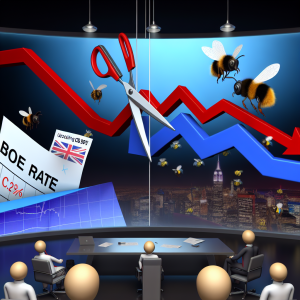The UK Economy at a Crossroads: What the Latest Data Means for Investors and the BoE’s Next Moves
Recent UK labor market data paints a sobering picture: employment conditions are showing signs of weakening. Yet, despite these headwinds, the Bank of England (BoE) appears poised to maintain its current monetary policy stance—at least for now. But don’t be lulled into complacency. The economic signals coming out of the UK suggest a pivotal moment is near, one that savvy investors and financial advisors should watch closely.
GDP Data Strengthens the Case for Rate Cuts — But Inflation Could Spoil the Party
The latest GDP figures add fuel to growing speculation that the BoE may soon pivot toward easing, possibly delivering a rate cut in the near term. This dovish tilt is driven by a slowing economy that demands monetary support to sustain growth. However, the critical wildcard remains the upcoming UK inflation report, due June 18. Economists forecast a slight uptick in headline inflation from 3.5% in April to 3.6% in May. While this may seem modest, even a small inflation rise can complicate the BoE’s decision-making.
If inflation surprises on the upside, it could force the BoE to maintain higher rates for longer, delaying any rate cuts and potentially unsettling markets. This delicate balancing act—between supporting growth and containing inflation—is the defining challenge for the BoE right now.
Market Expectations: Are Rate Cuts Already Priced In?
According to a Reuters poll conducted from June 5 to 10, economists overwhelmingly expect the BoE to cut rates by 25 basis points in August, with another cut anticipated in the fourth quarter of 2025. This would lower the benchmark rate to 3.75%, signaling a clear dovish turn.
The markets have largely priced in these expectations, with futures contracts reflecting two rate cuts by year-end. However, the final BoE decision will likely hinge on the June inflation data. Investors should be prepared for volatility around this release, as any deviation from forecasts could trigger sharp market moves.
GBP/USD Volatility: A Barometer of Market Sentiment
The British pound’s recent dance against the US dollar offers a window into market sentiment. Ahead of the April GDP report, GBP/USD briefly dipped to $1.35351 before rebounding to $1.35928. After the report’s release, the pair fell from $1.35880 to $1.35556, mirroring expectations of a more dovish BoE stance.
By June 12, the pound had clawed back slightly, trading at $1.35617, up 0.18%. This tug-of-war reflects the uncertainty gripping investors as they weigh the BoE’s next moves amid mixed economic signals.
What This Means for Investors and Advisors: Strategic Takeaways
-
Stay Nimble on UK Exposure: Given the BoE’s delicate balancing act, UK assets—especially gilts and sterling—could experience heightened volatility. Investors with UK exposure should consider hedging strategies or diversifying to mitigate risks.
-
Monitor Inflation Data Closely: The June inflation report is a critical data point. Advisors should prepare clients for potential market swings around this release and reassess portfolio positioning based on the BoE’s response.
-
Look Beyond the Headlines: The labor market weakening signals underlying economic stress that could persist. Investors should watch for broader signs of slowing growth in sectors like retail and manufacturing, which could influence BoE policy longer term.
- Consider Global Context: The BoE’s decisions do not occur in isolation. With the Federal Reserve and European Central Bank also navigating inflation and growth challenges, cross-market dynamics will influence currency flows and investment returns. For example, if the Fed maintains a more hawkish stance, the pound could face additional downward pressure against the dollar.
Unique Insight: The BoE’s Rate Cuts Could Signal a Shift Toward Growth-Focused Policy
While the market expects rate cuts, it’s crucial to understand that these moves may mark a strategic shift for the BoE—from fighting inflation to actively supporting growth. This pivot could open opportunities in UK equities, particularly in sectors sensitive to economic cycles like consumer discretionary and financials.
A recent analysis by the IMF suggests that central banks globally are entering a new phase where growth stabilization takes precedence over inflation targeting alone. The BoE’s potential rate cuts could be the UK’s entry into this phase, creating a window for investors to capitalize on a growth rebound.
What’s Next?
- June 18: UK inflation report—expect volatility.
- August: Potential first BoE rate cut—prepare for market reactions.
- Q4 2025: Another expected cut—watch for confirmation and economic signals.
In conclusion, the UK economy stands at a crossroads, with the BoE’s next moves pivotal for markets. Investors and advisors who anticipate these shifts, monitor key data closely, and adjust strategies proactively will be best positioned to navigate the evolving landscape.
For those seeking a competitive edge, understanding the nuanced interplay between inflation, growth, and monetary policy in the UK is no longer optional—it’s essential. Stay informed, stay agile, and be ready to act.
Source: UK GDP Slide Fuels BoE Rate Cut Speculation Ahead of Key CPI Report; GBP/USD Dips

